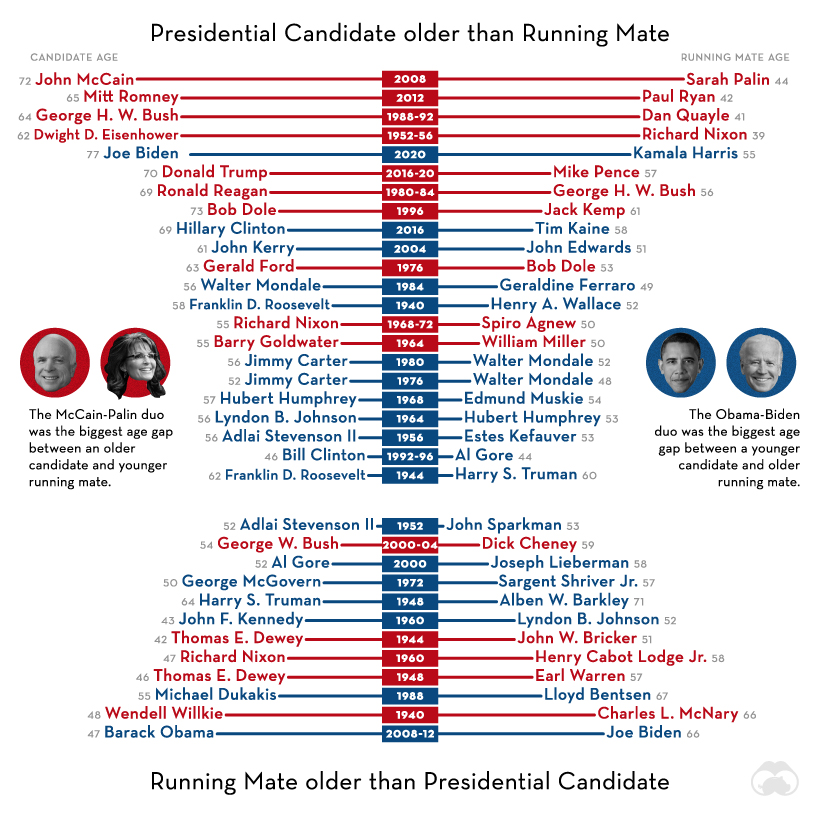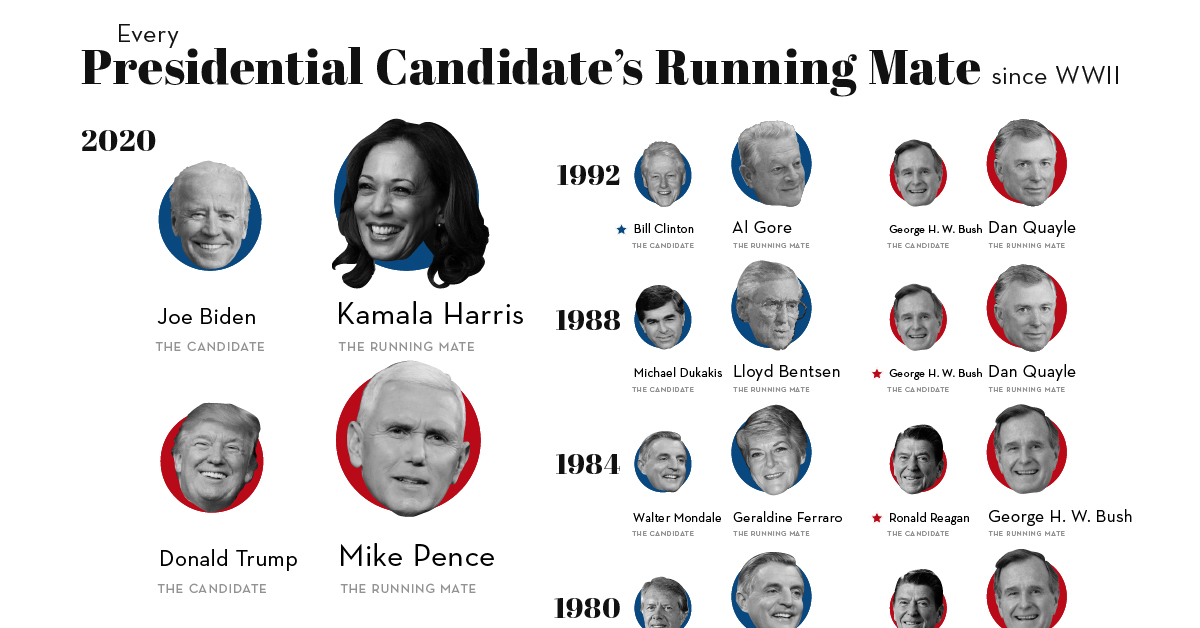Politics
Every Presidential Candidate’s Running Mate Since WWII

Every Presidential Candidate’s Running Mate Since WWII
Since the U.S. Constitution was first instituted, there have been 48 vice presidents. They’ve supported presidents in seeing the country through wars, economic expansions and contractions, a global pandemic—and much more.
A president’s success depends on the strength of their team, so it’s only natural that as second-in-command, the pick for a VP carries significant weight. In some cases, they can even make or break the race to secure a spot in the White House.
In this graphic, we take a look at the hand-picked running mates of presidential hopefuls since 1940, including the upcoming November 2020 elections.
Running More Than Once
The graphic highlights 33 running mates, out of which nine have ran for VP more than once. Here’s how their number of terms compare, and who continued on to become an eventual presidential candidate:
| Running Mate | Party | VP terms served | Presidential candidate? |
|---|---|---|---|
| Mike Pence | 🔴 R | Won 1 term Currently running for second term | No |
| Joe Biden | 🔵 D | Won both terms | Currently running for president |
| Dick Cheney | 🔴 R | Won both terms | No |
| Al Gore | 🔵 D | Won both terms | Yes, but did not win first term |
| Dan Quayle | 🔴 R | Won 1 out of 2 terms | No |
| George H. W. Bush | 🔴 R | Won both terms | Yes, won one term |
| Spiro Agnew | 🔴 R | Won both terms | Resigned during VP second term |
| Richard Nixon | 🔴 R | Won both terms | Yes, won both terms |
| Walter Mondale | 🔵 D | Won 1 out of 2 terms | Yes, but did not win first term |
Of the running mates since WWII, Republicans Richard Nixon and George H. W. Bush are the only two to have served as president after being vice presidents for two previous terms—unless Joe Biden wins in November 2020.
Prior Gigs
What career paths did aspiring VPs take before running on the big ticket?
Interestingly, 2 of 3 running mates profiled in today’s graphic had a prior background as a lawyer before choosing to enter politics.
A curious exception to the typical career path is that of former professional football player Jack Kemp, who was chosen as the running mate for Bob Dole’s unsuccessful presidential bid in 1996.
At the President’s Right Hand
The vice president is the first in line of succession for the Oval Office, in the event that the sitting president dies, resigns, or is removed from office. Throughout history, nine VPs have ascended to presidency this way, of which three occurred since 1940.
- After Franklin D. Roosevelt’s death in 1945, Harry S. Truman ascended to the presidency.
- Lyndon B. Johnson became the President upon John F. Kennedy’s assassination in 1963.
- Following evidence of political corruption, Spiro Agnew resigned in 1973. He was replaced by Gerald Ford, who then became President after Nixon’s post-Watergate resignation in 1974.
Richard Nixon, Bill Clinton, and Donald Trump are three Presidents who have been through the impeachment process, but were later acquitted by the Senate. Otherwise, the list of VPs ending up as the commander-in-chief might look much more different.
The Youngest and Oldest Running Mates
Based on the first time they ran on the ticket, the average running mate is 54 years old. In contrast, the average presidential candidate is 58 years old.
Comparing the age difference between presidential candidates and their running mates paints a unique picture. The biggest age gaps both occurred in 2008:

There was a 28-year difference between older candidate John McCain (72) and younger VP pick Sarah Palin (44) on the Republican ticket. On the Democratic side, younger candidate Barack Obama (47) and older VP pick Joe Biden (66) saw a 19-year gap.
Harry S. Truman’s historic win in 1948 was considered a surprising political longshot. His running mate, Alben W. Barkley was the oldest running mate ever picked, 71 years at the time.
Meanwhile, Richard Nixon was one of the youngest running mates to be chosen, 39 years in 1956—second only to John C. Breckinridge (36 years old in 1856). Finally, at age 92 years in 2020, Walter Mondale is the oldest living former VP.
Cracking the Glass Ceiling
Last but not least, there have only been three women selected as VP running mates to date.
- Geraldine Ferraro became the first woman VP nominee for the Democratic Party in 1984.
- Although she had only two years of political experience as governor of Alaska, Sarah Palin was the first female Republican VP nominee in 2008.
- Kamala Harris, a former prosecutor with almost four years of experience as a Senator, is the first woman of color to be nominated on any major party’s ticket in 2020.
Palin herself shared a few words of wisdom for Harris across the aisle:
Congrats to the democrat VP pick 🇺🇸 Climb upon Geraldine Ferraro’s and my shoulders, and from the most amazing view in your life consider lessons we learned…
—Sarah Palin (via Instagram)
Could Harris become the first ever right-hand woman? We’ll find out in a few months.
Economy
The Bloc Effect: International Trade with Geopolitical Allies on the Rise
Rising geopolitical tensions are shaping the future of international trade, but what is the effect on trading among G7 and BRICS countries?

The Bloc Effect: International Trade with Allies on the Rise
International trade has become increasingly fragmented over the last five years as countries have shifted to trading more with their geopolitical allies.
This graphic from The Hinrich Foundation, the first in a three-part series covering the future of trade, provides visual context to the growing divide in trade in G7 and pre-expansion BRICS countries, which are used as proxies for geopolitical blocs.
Trade Shifts in G7 and BRICS Countries
This analysis uses IMF data to examine differences in shares of exports within and between trading blocs from 2018 to 2023. For example, we looked at the percentage of China’s exports with other BRICS members as well as with G7 members to see how these proportions shifted in percentage points (pp) over time.
Countries traded nearly $270 billion more with allies in 2023 compared to 2018. This shift came at the expense of trade with rival blocs, which saw a decline of $314 billion.
Country Change in Exports Within Bloc (pp) Change in Exports With Other Bloc (pp)
🇮🇳 India 0.0 3.9
🇷🇺 Russia 0.7 -3.8
🇮🇹 Italy 0.8 -0.7
🇨🇦 Canada 0.9 -0.7
🇫🇷 France 1.0 -1.1
🇪🇺 EU 1.1 -1.5
🇩🇪 Germany 1.4 -2.1
🇿🇦 South Africa 1.5 1.5
🇺🇸 U.S. 1.6 -0.4
🇯🇵 Japan 2.0 -1.7
🇨🇳 China 2.1 -5.2
🇧🇷 Brazil 3.7 -3.3
🇬🇧 UK 10.2 0.5
All shifts reported are in percentage points. For example, the EU saw its share of exports to G7 countries rise from 74.3% in 2018 to 75.4% in 2023, which equates to a 1.1 percentage point increase.
The UK saw the largest uptick in trading with other countries within the G7 (+10.2 percentage points), namely the EU, as the post-Brexit trade slump to the region recovered.
Meanwhile, the U.S.-China trade dispute caused China’s share of exports to the G7 to fall by 5.2 percentage points from 2018 to 2023, the largest decline in our sample set. In fact, partly as a result of the conflict, the U.S. has by far the highest number of harmful tariffs in place.
The Russia-Ukraine War and ensuing sanctions by the West contributed to Russia’s share of exports to the G7 falling by 3.8 percentage points over the same timeframe.
India, South Africa, and the UK bucked the trend and continued to witness advances in exports with the opposing bloc.
Average Trade Shifts of G7 and BRICS Blocs
Though results varied significantly on a country-by-country basis, the broader trend towards favoring geopolitical allies in international trade is clear.
Bloc Change in Exports Within Bloc (pp) Change in Exports With Other Bloc (pp)
Average 2.1 -1.1
BRICS 1.6 -1.4
G7 incl. EU 2.4 -1.0
Overall, BRICS countries saw a larger shift away from exports with the other bloc, while for G7 countries the shift within their own bloc was more pronounced. This implies that though BRICS countries are trading less with the G7, they are relying more on trade partners outside their bloc to make up for the lost G7 share.
A Global Shift in International Trade and Geopolitical Proximity
The movement towards strengthening trade relations based on geopolitical proximity is a global trend.
The United Nations categorizes countries along a scale of geopolitical proximity based on UN voting records.
According to the organization’s analysis, international trade between geopolitically close countries rose from the first quarter of 2022 (when Russia first invaded Ukraine) to the third quarter of 2023 by over 6%. Conversely, trade with geopolitically distant countries declined.
The second piece in this series will explore China’s gradual move away from using the U.S. dollar in trade settlements.

Visit the Hinrich Foundation to learn more about the future of geopolitical trade

-

 Misc14 mins ago
Misc14 mins agoVisualizing the Most Common Pets in the U.S.
Lions, tigers, and bears, oh my!—these animals do not feature on this list of popular American household pets.
-

 Economy3 days ago
Economy3 days agoEconomic Growth Forecasts for G7 and BRICS Countries in 2024
The IMF has released its economic growth forecasts for 2024. How do the G7 and BRICS countries compare?
-

 United States2 weeks ago
United States2 weeks agoRanked: The Largest U.S. Corporations by Number of Employees
We visualized the top U.S. companies by employees, revealing the massive scale of retailers like Walmart, Target, and Home Depot.
-

 United States2 weeks ago
United States2 weeks agoWhere U.S. Inflation Hit the Hardest in March 2024
We visualized product categories that saw the highest % increase in price due to U.S. inflation as of March 2024.
-

 Economy1 month ago
Economy1 month agoG20 Inflation Rates: Feb 2024 vs COVID Peak
We visualize inflation rates across G20 countries as of Feb 2024, in the context of their COVID-19 pandemic peak.
-

 Jobs1 month ago
Jobs1 month agoMapped: Unemployment Claims by State
This visual heatmap of unemployment claims by state highlights New York, California, and Alaska leading the country by a wide margin.
-

 Culture1 week ago
Culture1 week agoThe Highest Earning Athletes in Seven Professional Sports
-

 Demographics2 weeks ago
Demographics2 weeks agoPopulation Projections: The World’s 6 Largest Countries in 2075
-

 Markets2 weeks ago
Markets2 weeks agoThe Top 10 States by Real GDP Growth in 2023
-

 Demographics2 weeks ago
Demographics2 weeks agoThe Smallest Gender Wage Gaps in OECD Countries
-

 United States2 weeks ago
United States2 weeks agoWhere U.S. Inflation Hit the Hardest in March 2024
-

 Green2 weeks ago
Green2 weeks agoTop Countries By Forest Growth Since 2001
-

 United States2 weeks ago
United States2 weeks agoRanked: The Largest U.S. Corporations by Number of Employees
-

 Maps2 weeks ago
Maps2 weeks agoThe Largest Earthquakes in the New York Area (1970-2024)
















